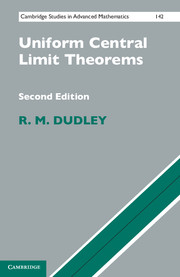Book contents
- Frontmatter
- Dedication
- Contents
- Preface to the Second Edition
- 1 Donsker's Theorem and Inequalities
- 2 Gaussian Processes; Sample Continuity
- 3 Definition of Donsker Classes
- 4 Vapnik–Červonenkis Combinatorics
- 5 Measurability
- 6 Limit Theorems for VC-Type Classes
- 7 Metric Entropy with Bracketing
- 8 Approximation of Functions and Sets
- 9 Two Samples and the Bootstrap
- 10 Uniform and Universal Limit Theorems
- 11 Classes Too Large to Be Donsker
- Appendices
- Bibliography
- Notation Index
- Author Index
- Subject Index
- References
Bibliography
Published online by Cambridge University Press: 05 June 2014
- Frontmatter
- Dedication
- Contents
- Preface to the Second Edition
- 1 Donsker's Theorem and Inequalities
- 2 Gaussian Processes; Sample Continuity
- 3 Definition of Donsker Classes
- 4 Vapnik–Červonenkis Combinatorics
- 5 Measurability
- 6 Limit Theorems for VC-Type Classes
- 7 Metric Entropy with Bracketing
- 8 Approximation of Functions and Sets
- 9 Two Samples and the Bootstrap
- 10 Uniform and Universal Limit Theorems
- 11 Classes Too Large to Be Donsker
- Appendices
- Bibliography
- Notation Index
- Author Index
- Subject Index
- References
- Type
- Chapter
- Information
- Uniform Central Limit Theorems , pp. 449 - 462Publisher: Cambridge University PressPrint publication year: 2014



